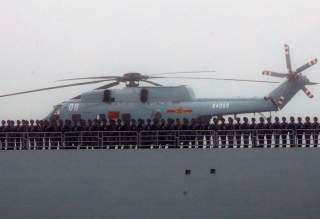Meet the Type 075: China's First Helicopter Assault Ship
A dangerous new addition.
Key point: LHDs will help PLAN's Marines launch assaults and get air support. They are similar to America's own Wasp and America class ships.
A Chinese shipyard has begun assembling the People’s Liberation Army Navy’s first big-deck amphibious assault ship, or “LHD” in U.S. Navy parlance.
This first appeared in June 2019 and is being reposted due to reader interest.
The incomplete hull of the first Type 075 LHD apparently is visible in June 2019 commercial satellite images of the Hudong–Zhonghua shipyard in Shanghai.
LHDs, which combine the functions of helicopter carriers and transport docks, can deploy landing craft, hovercraft, helicopters and vertical-launching fighters while also transporting hundreds of soldiers or marines.
The U.S. Navy possesses nine Wasp- and America-class LHDs and is building several more. In U.S. service, LHDs not only form the core of amphibious groups, they also can embark large numbers of AV-8B or F-35B jump jets in order to double as light aircraft carriers.
China lacks a jump jet, so the country for now doesn’t have the option of deploying LHDs as carriers. But LHDs in Chinese service could help the PLAN assert Beijing’s claims to disputed China Seas territories as well as join smaller Type 071 assault ships in any Chinese assault on Taiwan.
“A landing helicopter dock-type amphibious assault ship has long been predicted for the PLA Navy in the years after the 071 landing platform/dock emerged,” Rick Joe wrote at The Diplomat in late 2018. “One export model LHD has been showcased, displacing about 20,000 tons, but the PLA Navy’s future LHD will likely be substantially larger.”
The designation of the LHD is 075; however, in earlier years it has been incorrectly named as 081 in a number of publications. The 075 is thought to have a full displacement less than 40,000 tons, perhaps around 36,000 to 38,000 tons. Such a displacement would be smaller than the America or Wasp classes in service with the U.S. Navy, but would still be the largest non-U.S. LHD or LHA by a significant margin.
Currently it is thought that three 075s have been ordered by the PLA Navy, with initial work on the first two having commenced within the last year or more. The class is to be built at Hudong Zhonghua shipyard, the same facility that built all of the PLA Navy’s 071 LPDs.
Considering the timespan in which the rumors about the lead 075’s construction began to emerge, it is likely that photo confirmation of the lead 075 will be attained within the next year or so, likely in a late stage of assembly before the ship is ready to launch.
The Chinese navy’s amphibious fleet in recent years has grown and improved. “China’s investments in its amphibious ship force signal its intent to develop expeditionary warfare capabilities,” according to the 2019 edition of the U.S. Defense Department’s annual report on Chinese military developments.
The PLAN has five large [Type 071] Yuzhao-class ... amphibious transport docks, with three more under construction or outfitting during 2018. The Yuzhao LPD provides a greater and more flexible capability for long-range operations than the PLAN’s older landing ships. It can carry several of the new Yuyi-class air-cushion medium landing craft and four or more helicopters, as well as armored vehicles and PLAN marines for long-distance deployments.
The PLAN probably will continue constructing Yuzhao LPDs even as it pursues a follow-on amphibious assault ship that is not only larger but also incorporates a full flight deck for helicopters.
LHDs will be boon to Chinese power-projection. But even with a larger amphibious fleet including big-deck assault ships, Beijing could struggle to defeat Taiwan in a conventional invasion scenario, according to the Pentagon report.
“Large-scale amphibious invasion is one of the most complicated and difficult military operations. Success depends upon air- and maritime-superiority, the rapid buildup and sustainment of supplies onshore and uninterrupted support.”
“These stresses, combined with China’s combat force attrition and the complexity of urban warfare and counterinsurgency, even assuming a successful landing and breakout, make an amphibious invasion of Taiwan a significant political and military risk.”
David Axe serves as Defense Editor of the National Interest. He is the author of the graphic novels War Fix, War Is Boring and Machete Squad. This first appeared in June 2019 and is being reposted due to reader interest.
Image: Reuters

